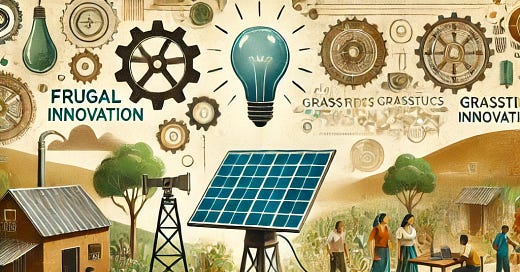Forget sleek gadgets and big budgets. The frugal innovation movement is rewriting the rules of progress by proving that groundbreaking solutions don’t need to be expensive or extravagant. Instead, it’s about leveraging constraints to create products, services, and processes that are effective, affordable, and accessible to all.
Frugal innovation goes beyond traditional innovation by prioritizing inclusivity, resourcefulness, and sustainability. Let’s explore how this approach is reshaping industries, addressing critical global challenges, and inspiring a revolution in how we innovate.
What Is Frugal Innovation?
Frugal innovation is the art of doing more with less. It emphasizes:
Cost-Effectiveness: Developing affordable solutions that meet essential needs without compromising quality.
Resource Efficiency: Using fewer materials, energy, and time to create impactful products or services.
Inclusivity: Designing for underserved populations, ensuring accessibility regardless of income, geography, or infrastructure.
This philosophy emerged in regions where resources are limited but ingenuity is abundant—places like India, Africa, and parts of Latin America. However, its principles are now being adopted worldwide as companies and communities recognize the power of simplicity and adaptability.
Frugal Innovation in Action
Frugal innovation is already driving meaningful change across industries. Here are some standout examples:
Affordable Healthcare
The Aravind Eye Hospital in India provides high-quality cataract surgeries for a fraction of the typical cost through streamlined processes and reusable instruments.
GE’s Portable Ultrasound Machine, priced at under $8,000 (compared to standard models costing $100,000), brings diagnostic imaging to remote areas.
Sustainable Agriculture
Drip irrigation systems, such as those from Jain Irrigation, use minimal water to maximize crop yields, addressing drought and water scarcity in farming communities.
Low-cost, solar-powered water pumps are transforming small-scale farming in Sub-Saharan Africa.
Accessible Education
Apps like Khan Academy deliver free, high-quality educational content to millions worldwide.
The Solar-Powered Classroom in a Box, developed by Aleutia, equips remote schools with laptops, preloaded learning materials, and solar panels.
Financial Inclusion
M-Pesa, a mobile banking service in Kenya, enables people without traditional bank accounts to send, receive, and save money securely.
Microfinance initiatives, such as those from Grameen Bank, provide small loans to empower entrepreneurs in low-income communities.
The Benefits of Frugal Innovation
Frugal innovation isn’t just about cutting costs—it’s about creating transformative impact. Here’s how:
Social Impact
It tackles urgent challenges like healthcare, education, and climate change by making solutions accessible to underserved populations.
Economic Growth
By focusing on affordability, frugal innovation unlocks new markets, particularly in developing regions, fostering entrepreneurship and local economies.
Sustainability
Resource-efficient designs reduce waste and environmental footprints, aligning with the principles of circular economies.
Increased Accessibility
Frugal innovation bridges gaps in infrastructure and affordability, ensuring more people can benefit from advancements in technology and services.
The Frugal Innovation Mindset
Embracing frugal innovation requires a mindset shift—from viewing limitations as obstacles to seeing them as opportunities. Here are its core principles:
Embrace Constraints
Constraints fuel creativity. Whether it’s a limited budget or scarce materials, finding innovative ways to work within boundaries often leads to simpler, more effective solutions.
Focus on Affordability
Prioritize affordability in design and production, ensuring solutions are accessible to the largest number of people.
Collaborate and Co-Create
Engage directly with end-users, communities, and stakeholders to understand their needs and co-develop practical solutions.
Think Outside the Box
Challenge traditional methods and explore unconventional approaches, such as repurposing materials, leveraging local resources, or applying existing technologies in new ways.
How to Encourage Frugal Innovation
Support Grassroots Initiatives
Invest in local entrepreneurs and community-based solutions. Grassroots efforts often yield ideas uniquely suited to their contexts.
Incentivize Simplicity
Governments, NGOs, and corporations can offer grants, prizes, or recognition for innovations that prioritize cost-effectiveness and impact.
Leverage Open Innovation
Encourage collaboration by sharing resources, ideas, and platforms across organizations, industries, and countries.
Educate and Empower
Promote problem-solving skills and entrepreneurial thinking in schools and communities to inspire the next generation of innovators.
Additional Resources on Frugal Innovation
Books:
Frugal Innovation: How to Do Better with Less by Navi Radjou and Jaideep Prabhu: A must-read guide to the principles and applications of frugal innovation.
Jugaad Innovation by Navi Radjou, Jaideep Prabhu, and Simone Ahuja: A look at how resourcefulness drives innovation in emerging markets.
Case Studies and Reports:
The World Economic Forum offers insights on how frugal innovation is driving global development.
The Ashoka Foundation highlights grassroots innovators tackling real-world challenges.
Organizations:
IDEO.org: Focuses on human-centered design for social innovation.
MIT D-Lab: Develops technologies and ventures for underserved communities.
The Takeaway
Frugal innovation proves that constraints can be a powerful catalyst for creativity. By focusing on affordability, accessibility, and resource efficiency, it addresses global challenges while creating sustainable opportunities for growth.
This movement challenges the notion that bigger is always better. Instead, it shows that some of the most impactful solutions come from doing more with less. By embracing frugal innovation, we can create a more inclusive, sustainable, and resourceful future for all.





